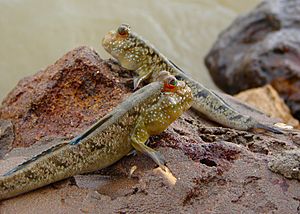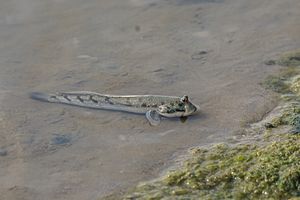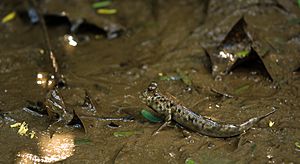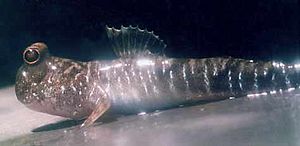Mudskipper facts for kids
Quick facts for kids Mudskipper |
|
|---|---|
 |
|
| Periophthalmus barbarus mudskippers in The Gambia | |
| Scientific classification |
|
| Kingdom: | Animalia |
| Phylum: | Chordata |
| Class: | Actinopterygii |
| Order: | Gobiiformes |
| Family: | Oxudercidae |
| Subfamily: | Oxudercinae Gunther 1861 |
| Genera | |
|
Apocryptes |
|
| Synonyms | |
|
|
Mudskippers are super cool fish that can live both in and out of water! There are about 23 different kinds of mudskippers. They belong to a group of fish called gobies. They look a bit unusual and love living in muddy, watery places. What makes them special is their amazing ability to move around on land and even jump! They can stay out of water for a long time.
Mudskippers can grow up to 30 cm (12 in) (about 1 foot) long. Most of them are a brownish-green color, from light to dark. When it's time to find a mate, male mudskippers get bright spots on their bodies. These spots can be red, green, or blue, and they help attract females.
Unlike most fish, mudskippers have eyes that stick out from the top of their flat heads. But their most amazing feature is their strong side fins, called pectoral fins. These fins are located more forward on their body. They are jointed, almost like tiny arms, which lets the mudskipper crawl from place to place. These front fins help them "skip" across muddy surfaces, which is how they got their name! They can even climb onto low tree branches and bushes. Mudskippers can also leap up to 2 feet (0.61 m) (about 60 cm) by bending their tails and pushing off.
Contents
What Are Mudskippers?
Mudskippers are a special type of goby fish. Scientists used to think they were part of the main goby family. But newer studies show they are a unique group. Mudskippers are defined as gobies that spend a lot of their day completely out of the water. This includes types like Boleophthalmus, Periophthalmodon, Periophthalmus, and Scartelaos. Even the Zappa confluentus is now considered a mudskipper because it also spends time on land.
Mudskipper Life and Habits
Mudskippers usually live in burrows they dig in muddy areas where the tide goes in and out. They have special ways to live in this environment that most other fish don't. Most fish hide under wet seaweed or in tide pools when the water goes out. Mudskippers, however, build burrows with smooth, rounded ceilings.
Building Burrows
The way male mudskippers dig their burrows helps them survive when the water has very little oxygen. These burrows are also super important for the eggs to develop safely inside.
Finding a Mate
Once a male finishes digging his burrow, he comes out to attract a female. He does this by wiggling his body, striking different poses, and making energetic movements. When a female chooses a male, she follows him into the burrow. There, she lays hundreds of eggs, and the male fertilizes them. After that, the female usually leaves. The male then stays to guard the eggs from hungry predators.
Life on Land
Mudskippers are very active when they are out of the water. They search for food and interact with each other. For example, they defend their territories and try to find partners. They can spend up to three-quarters of their lives on land! You can find them in warm and mild areas around the world. This includes places near the Indian Ocean and Pacific Ocean, and the Atlantic Ocean coast of Africa.
How Mudskippers Survive on Land
Mudskippers have amazing body features and behaviors that help them move and breathe both on land and in water.
Moving on Land
As their name suggests, these fish use their fins to "skip" around. Their pectoral fins are different from most fish. They have long bones that stick out from their body. This creates a fin with two parts and two movable joints. One joint acts like a "shoulder," and another joint is inside the fin itself. This special design allows them to move their fins almost like arms, helping them crawl and skip.
Breathing Out of Water


Mudskippers can breathe through their skin and the lining of their mouth and throat. This only works if they stay wet, so they need to live in humid places and keep their skin moist. This way of breathing is similar to how amphibians breathe.
They also have large gill chambers that can hold a bubble of air. When they are out of water, these chambers close tightly. This keeps their gills moist and allows them to still work in the air. Their gill parts are stiff, so they don't stick together when out of water.
What Mudskippers Eat
Different types of mudskippers have different diets. Some, like Boleophthalmus boddarti, eat tiny bits of decaying plants and animals (detritus). Others eat small crabs, insects, snails, and sometimes even other mudskippers!
Why They Burrow
Digging deep burrows in soft mud helps mudskippers in several ways:
- It helps them control their body temperature.
- It protects them from predators when the tide comes in and the burrow is underwater.
- It's where they lay their eggs.
When the burrow is underwater, many mudskipper species keep an air pocket inside. This lets them breathe even if the water has very little oxygen.
Dealing with Ammonia
Fish produce a waste product called ammonia, which can be toxic. Mudskippers have special ways to deal with this when they are out of water. They can slow down how much ammonia their bodies make. They can also make the water in their burrows more acidic, which helps reduce ammonia levels from their surroundings.
How Mudskippers Blink
Mudskippers have developed the ability to blink, just like land animals, even though they are fish! Their eyes are high on their heads. They blink by lowering their eyes while a special membrane, called the dermal cup, rises to cover them. They don't have special muscles or glands for blinking like land animals do. The fluid on their eyes is probably mucus from their skin and water from their environment.
Mudskippers likely developed blinking to keep their eyes wet when out of water and to clean and protect them from dirt. They blink more often when it's dry and when something might hit their eyes in the air. Young mudskippers, who live fully in water, don't have elevated eyes and don't blink.
Types of Mudskippers
The Periophthalmus group is the most common and widespread type of mudskipper. There are 18 known species in this group.
Periophthalmus argentilineatus is one of the most well-known species. You can find it in mangrove forests and mudflats from East Africa to Japan and Australia. It grows to about 9.5 cm (3.7 inches) long. It's a meat-eater that eats small crabs and other insects. However, scientists now think that P. argentilineatus might actually be several different species that look very similar.
Another species, Periophthalmus barbarus, is the only mudskipper found along the coast of western Africa.
Images for kids
-
Periophthalmus barbarus mudskippers in The Gambia
-
Mudskipper at Point Calimere Sanctuary, Tamil Nadu, India
-
Mudskipper at Coringa Mangrove Sanctuary, Andhra Pradesh, India
See also
 In Spanish: Oxudercinae para niños
In Spanish: Oxudercinae para niños








